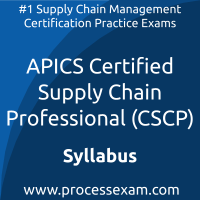 To achieve the professional designation of ASCM APICS Certified Supply Chain Professional from the ASCM, candidates must clear the CSCP Exam with the minimum cut-off score. For those who wish to pass the ASCM APICS Certified Supply Chain Professional certification exam with good percentage, please take a look at the following reference document detailing what should be included in ASCM APICS CSCP Exam preparation.
To achieve the professional designation of ASCM APICS Certified Supply Chain Professional from the ASCM, candidates must clear the CSCP Exam with the minimum cut-off score. For those who wish to pass the ASCM APICS Certified Supply Chain Professional certification exam with good percentage, please take a look at the following reference document detailing what should be included in ASCM APICS CSCP Exam preparation.
The ASCM CSCP Exam Summary, Body of Knowledge (BOK), Sample Question Bank and Practice Exam provide the basis for the real APICS Certified Supply Chain Professional (CSCP) exam. We have designed these resources to help you get ready to take ASCM APICS Certified Supply Chain Professional (CSCP) exam. If you have made the decision to become a certified professional, we suggest you take authorized training and prepare with our online premium ASCM APICS Certified Supply Chain Professional Practice Exam to achieve the best result.
ASCM CSCP Exam Summary:
| Exam Name | ASCM APICS Certified Supply Chain Professional |
| Exam Code | CSCP |
| Exam Fee | USD $1,420 |
| Exam Duration | 210 Minutes |
| Number of Questions | 150 |
| Passing Score | 300 / 350 |
| Format | Multiple Choice Questions |
| Books / Trainings | APICS 2025 CSCP Self-Study Exam Prep |
| Schedule Exam | Pearson VUE |
| Sample Questions | ASCM APICS CSCP Exam Sample Questions and Answers |
| Practice Exam | APICS Certified Supply Chain Professional (CSCP) Practice Test |
ASCM APICS Certified Supply Chain Professional Syllabus Topics:
| Topic | Details |
|---|---|
| Supply Chains, Demand Management, and Forecasting |
- Introduction to Supply Chains - Demand Analysis and Patterns - Demand Management - Forecasting - Supply and Demand Alignment |
| Global Supply Chain Networks |
- Supply Chain Design and Optimization - End-to-End Connectivity and Visibility - Supply Chain Metrics and Reports |
| Sourcing Products and Services |
- Aligning Sourcing to Demand - Category Strategy for Sourcing - Product Design Influence - Supplier Selection, Contracting, and Use |
| Internal Operations and Inventory |
- Planning Operations - Capacity and Production Activity Control - Inventory - Performance and Continuous Improvement |
| Forward and Reverse Logistics |
- Logistics and Distribution - Distribution Services and Transportation Choices - Trade Considerations - Reverse Flow |
| Supply Chain Relationships |
- Customer Relationships - Supplier and Supply Chain Relationships |
| Supply Chain Risk |
- Risk Management and Supply Chain Risks - Risk Analysis and Response |
| Optimization, Sustainability, and Technology |
- Optimizing Supply Chain Strategy and Tactics - Sustainability - Technology Trends |
Both ASCM and veterans who’ve earned multiple certifications maintain that the best preparation for a ASCM CSCP professional certification exam is practical experience, hands-on training and practice exam. This is the most effective way to gain in-depth understanding of ASCM APICS CSCP concepts. When you understand techniques, it helps you retain ASCM APICS Certified Supply Chain Professional knowledge and recall that when needed.
